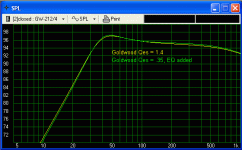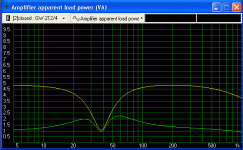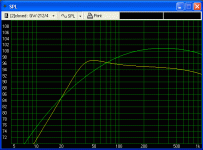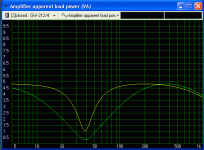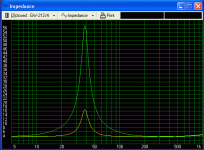it's easy to equalize low q driver, but it would put huge load on amplifier.
The Peerless 830452 drivers with Qts .17 Fs 18.9 take just 30V peak and 8W to reach xmax at 20Hz in free air which is hardly a "huge amplifier" or "huge load".
With a reasonable amplifier size (~60W) the amps will clip before the woofers bottom even when equalized to roll off second order at 20Hz with Q=.5. That's a feature, not a bug. You get full-range performance on music (which has little last octave content) without running the voice coils into the formers when there's something silly on a recording.
and you'd have to pay for equalizer, monster amp and expensive low Q woofer, just to achieve performance of a cheap high Q driver.
OPA2134s aren't much over $2 each in quantity (and a TL072 would suffice for half that), 1% resistors less than 10 cents each, and useful sized 2% film capacitors $1-$2 each. It's not a big deal.
Last edited:
Exactly. And when amp receives about +12db for Q correction and dipole roll off, it will clip much earlier than expected. Although I don't know how audible bass clipping is, maybe it actually sounds good... 🙂 Sorry people, I still think that equalization of low Q woofer + dipole boost is just a waste of power.With a reasonable amplifier size (~60W) the amps will clip before the woofers bottom even when equalized to roll off second order at 20Hz with Q=.5.
Last edited:
Mister,
Equalization, Q-correction, etc, and how it relates to power requirements is tricky for some folks to get their head around. You're not alone. 🙂
There are some excellent postings in this thread already. Dennis is right on the money as he always is.
Maybe this will help your understanding further:
http://www.linkwitzlab.com/faq.htm#Q34
Cheers,
Dave.
Equalization, Q-correction, etc, and how it relates to power requirements is tricky for some folks to get their head around. You're not alone. 🙂
There are some excellent postings in this thread already. Dennis is right on the money as he always is.
Maybe this will help your understanding further:
http://www.linkwitzlab.com/faq.htm#Q34
Cheers,
Dave.
Well Steve, you've got this same thread started on a myriad of different forums. 🙂 And it seems the same misunderstanding is happening in most of 'em. 🙂
Dave.
Dave.
Sorry people, I still think that equalization of low Q woofer + dipole boost is just a waste of power.
Not at the SPL level I listen at 🙂
There is a really good article from S. Linkwitz on power requirements for dipoles. I'm sure many of have seen it, but I have linked it for those of you that haven't seen it yet.
http://www.linkwitzlab.com/dipole_spl_limit.htm
If I read this article correctly Mr Linkwitz is saying that the capability of a driver to produce a certain SPL output is controlled by 3 factors: the excursion of the driver at the low end; the voltage output of the amplifier in the mid-bass; and the current output of the amplifier above that. I hope you can forgive my generalizations - he provides great detail in his analysis, but I'm trying to focus on general concepts here.
He ends his article this way:
This outlook makes sense. In order for a driver to make a sound at a certain SPL it must displace a certain volume of air. If you have adequate amplifier voltage and current capability, and enough excursion in your woofer you should be able to meet your output goals. It then becomes an issue of achieving a flat passband response.
Passband response is where there seems to be quite a bit of good discussion. Is it better to have a "pure" un-contoured signal path or one that is processed to produce the final transfer function of the system? High Qts or Low Qts? Wide baffle or narrow baffle?
Is it reasonable to discuss the output capability of the system separately from the response curve of the system?
http://www.linkwitzlab.com/dipole_spl_limit.htm
If I read this article correctly Mr Linkwitz is saying that the capability of a driver to produce a certain SPL output is controlled by 3 factors: the excursion of the driver at the low end; the voltage output of the amplifier in the mid-bass; and the current output of the amplifier above that. I hope you can forgive my generalizations - he provides great detail in his analysis, but I'm trying to focus on general concepts here.
He ends his article this way:
I'm fairly sure there is an implicit assumption that you are operating the driver within it's operating limits when he says this.Equalization merely shapes the acoustic frequency response and gives full use of a driver's capability.
This outlook makes sense. In order for a driver to make a sound at a certain SPL it must displace a certain volume of air. If you have adequate amplifier voltage and current capability, and enough excursion in your woofer you should be able to meet your output goals. It then becomes an issue of achieving a flat passband response.
Passband response is where there seems to be quite a bit of good discussion. Is it better to have a "pure" un-contoured signal path or one that is processed to produce the final transfer function of the system? High Qts or Low Qts? Wide baffle or narrow baffle?
Is it reasonable to discuss the output capability of the system separately from the response curve of the system?
You need to think of EQ as cutting the highs rather than boosting the lows. Low Q means the motor is stronger and, if you hold everything else equal, it uses less power not more.Exactly. And when amp receives about +12db for Q correction and dipole roll off, it will clip much earlier than expected. Although I don't know how audible bass clipping is, maybe it actually sounds good... 🙂 Sorry people, I still think that equalization of low Q woofer + dipole boost is just a waste of power.
Let's take that Goldwood you linked earlier with a Qes of 1.4. The yellow line is the SPL in an infinite baffle with 5 watts nominal which is enough to push it to Xmax. The green line is an identical driver except the magnet is twice as strong giving a Qes of .35. EQ is applied and the power adjusted so the curves line up pretty well.
Now look at how much power the two drivers are actually using to put out the same SPL. The one with low Q plus EQ is using less than half the power at most frequencies. At Fs, they both use about the same power.
Attachments
Last edited:
There's also the Silver Iris Augie from Hawthorne. It's a very nice driver designed specifically for open baffle.
http://www.hawthorneaudio.com/drivers.htm
http://www.hawthorneaudio.com/drivers.htm
Well Steve, you've got this same thread started on a myriad of different forums. 🙂 And it seems the same misunderstanding is happening in most of 'em. 🙂
Dave.
Always good to try and get different points of view, especially with these less than usual applications.
🙂
I was tempted by the GR servos, but have plumped for four of the AE IB12s.
catapult, your example makes sence. but I think it is applicable for closed boxes or IB subs only.
on open baffle high Q driver will always have more bass output than low Q driver, with same power applied.
open baffle equalization is a brute force approach.
sealed boxes is a different story IMO.
on open baffle high Q driver will always have more bass output than low Q driver, with same power applied.
open baffle equalization is a brute force approach.
sealed boxes is a different story IMO.
MisterTwister I am curious, why do you view mechanical equalization as superior to electrical equalization?
You need to think of EQ as cutting the highs rather than boosting the lows. Low Q means the motor is stronger and, if you hold everything else equal, it uses less power not more.
Two identical drivers, except the Qts, producing bass. Are you saying that the lower Qts driver plus EQ requires less power from the amp then the high Qts driver to produce equal SPL of bass output? Your plots seem to show this but it does not make sense to me.
Last edited:
applicable for closed boxes or IB subs only.
open baffle equalization is a brute force approach.
To me, fore any 3way or OB, it would be natural to EQ down to about 30hz, no more
Fore a dedicated sub 20-50hz, I dont know
edit, I didnt expect IBs to need EQ
I thought it was part of the game with IB, going very low without any further "help"
Last edited:
That's simply not true and we need to drive a stake through the heart of that myth. 😉 In an IB, like I showed, the driver is loaded exactly like an OB, i.e. no box contribution. For any given SPL at any given frequency other than Fs, the low-Q driver will use less power than the high-Q driver. At Fs, they use about the same power. You may not want to use EQ for whatever other reason but power is not a valid reason.catapult, your example makes sence. but I think it is applicable for closed boxes or IB subs only.
on open baffle high Q driver will always have more bass output than low Q driver, with same power applied.
open baffle equalization is a brute force approach.
sealed boxes is a different story IMO.
Hi Martin,Two identical drivers, except the Qts, producing bass. Are you saying that the lower Qts driver plus EQ requires less power from the amp then the high Qts driver to produce equal SPL of bass output? Your plots seem to show this but it does not make sense to me.
It makes sense if you step back and look at it in its simplest form. The only difference between the two drivers modeled is one has a bigger magnet. The one with the bigger magnet (lower Qes) will be more efficient at converting electrical current to mechanical motion. The EQ is really cutting the highs of the more efficient driver, not boosting the lows, to shape the response to how you want it.
For any given SPL at any given frequency other than Fs, the low-Q driver will use less power than the high-Q driver.
In your original post you wrote.
Low Q means the motor is stronger and, if you hold everything else equal, it uses less power not more.
By everything I also include SPL/W/m, if that is not the case then we are talking apples and oranges. So assuming two identical drivers, other than Qts, as you stated in your first post. If the two drivers have the same SPL/W/m at frequencies well above fs then near fs the low Qts driver will have less output then the high Qts driver for the same input power. Then to EQ the low Qts driver to raise its output to be equivalent to the high Qts driver it will require additional power. So when they produce the same SPL near fs the power required by the low Qts driver is greater than the high Qts driver ...... right?
Last edited:
Low Qts woofers, 0.3 or less, means early rolloff, hence not very effective very low
I take it medium Qts around 0.4 is NOT low
Its also a misunderstanding that more heavy coned woofers are less effective
At low frequency higher mms means more output, within certain limits
I take it medium Qts around 0.4 is NOT low
Its also a misunderstanding that more heavy coned woofers are less effective
At low frequency higher mms means more output, within certain limits
SPL/W/m (at whatever frequency that's measured) can't be held constant if you change the magnet. I'm just talking about pulling a 5 lb magnet off the driver and replacing it with a 10 lb magnet. Everything else about the physical driver stays the same.By everything I also include SPL/W/m, if that is not the case then we are talking apples and oranges.
Let me try a different approach. I guess it comes down to how you define efficiency. It's true that the higher-Q driver will have higher voltage sensitivity (SPL/2.83V/m) at a few frequencies. Here are both drivers with the same input voltage and no EQ.
But let's look at the actual power being used (VA). The low-Q driver is using much less power.
The reason is the higher impedance of the low-Q driver.
So, if you are mostly interested in the voltage limits of your amp, the high-Q driver might be better. But, if you are interested in the amp's current limits, the low-Q driver might be better. You really need to look at excursion vs. current vs. voltage as Linkwitz does rather than simplifying things too much.
Attachments
- Status
- Not open for further replies.
- Home
- Loudspeakers
- Multi-Way
- Open baffle bass - Dayton or AE IB12?
